How the visit to the landfill raise awareness of young people / Cum o vizită la groapa de gunoi i-a făcut pe tineri mai conștienți
On the 20th of June happened a trip to the landfill (first one organized by me) with EVS volunteers as well as local volunteers. During organization I asked to be a bit more specific with details to cause more impact since the participants majority of them were adult of teens so I wanted the visit to cause impact on them. 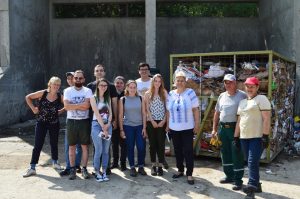
During the visit we had a lot of information with a lot of numbers we were given a lot of information about the different stages of waste sorting and how do they deal with the waste. For example what happens after the truck passes your house and takes your recyclables?.
They go to the landfill and are sorted manually by the employees of the sorting center and then they go different machines to be pressed and packed and after that according to the material (paper, plastic of different colors, glass) these new pressed and packed recyclables are sold to other companies in Prahova and these take over the recycling process.
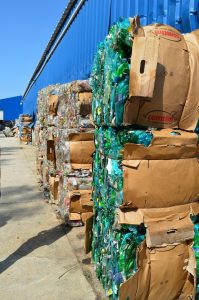 Ok so now you know what happens to the recyclables what about the rest of the trash?
Ok so now you know what happens to the recyclables what about the rest of the trash?
Well that was the shocking part in my opinion. The rest of the trash ends up in the landfill, which is currently reaching the maximum amounts and will soon have to be sealed!
The landfill has licence for 10 more years and if it keeps getting the trash at this rate will be sealed in less than 4 years. I think that the next step is to not throw everything together to the trash and pay even more attention and spread more the word about recycling.
All of this was very interesting in a point for us EVS to compare this system from what it is back in our countries. I know for me there are a lot of differences.
Just to finish this little Landfill visit walkthrought I wanted to point out that due to financial reasons a big part of the equipment that they have is not working because they don’t have the money for it and so on they need to use smaller machines which slows the process.
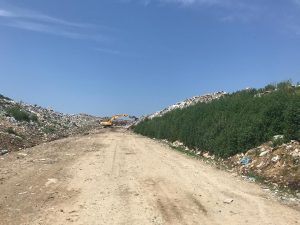
(Mountain of trash from the landfill)
After the visit I asked some question to the participants about the visit and got some very interesting answers and I was very pleased with them because I saw that the visit actually had some impact on them.
The questions were:
1– What kind of information did the visit to the landfill gave to you?
2– What was the thing that shook you the most?
3– What do you think we can do to change this situation?
The answer for questions one and two were pretty general most of the participants said that they got information that couldn’t get anywhere else, that there is a lot of waste coming to the landfill from very small areas, the people around don’t recycle enough and that the landfill didn’t had enough money to develop recycling process and to deal with more trash.
What shook them the most was pretty general as well and majority of the answer say that machines not working due to financial problems, the amount of trash that gets there and the lack of recycling around the commune.
When it comes to answer number three that’s where things spice up a little bit from revolution to “convince big players” against the use of plastic to spread the word and promote the idea of recycling but there is one answer that really stands out and I would like to share it with you.
“At the beginning a serious campaign to inform people what they can throw in their trash-bin( ex: that the
biodegradable stuff should not be put in there), the calendar for recycling materials( usually people loose the
counting and don’t know in which Wednesday the truck will come), what is the process at the landfill(some shocking
facts to trigger something in the people ́s minds) eventually to talk with a city hall representative and find together a
solution to deliver that information to the population. I strongly believe that we should work not only with kids, but also with
the grown ups because the decision about waste is in their hands and they really need a good speech in order to
start paying more attention to their waste.”
So does/did the landfill raised awareness to the young people?
I would say YES. At the end I got very good feedback and very good ideas and arguments regarding what they’ve saw in the landfill and also not only the participants but also me I was super shocked with all the info and I felt that we should do something about it. Visiting your local landfill is something that I really recommend specially if you are concerned with this environmental topic because you’ll see things that you never thought about it and in the end you’ll learn new stuff and you will see the reality of it.
I would like to thank Georgeta Marcu, responsible for environmental protection of the place and our guide who explained everything super clear and of course thanks to all the participants.
—
Pe 20 iunie a avut loc o excursie la depozitul de deșeuri (prima dată organizată de mine) cu voluntari EVS, precum și voluntari locali. În timpul organizării am cerut să fie un pic mai specific cu detalii pentru a provoca un impact mai mare, deoarece majoritatea participanților erau adulți sau adolescenți, am dorit ca vizita să provoace un impact asupra lor.
În timpul vizitei am primit multe informații cu o mulțime de numere, ni s-au oferit multe informații despre diferitele etape ale sortării deșeurilor și cum trebuie să se ocupe de acestea. De exemplu, ce se întâmplă după ce camionul trece pe la casa ta și îți ia reciclabilele.
Se duc la depozitul de deșeuri și sunt sortate manual de către angajații centrului de sortare, apoi merg spre diferite mașini pentru a fi presate și ambalate iar, după aceea, în funcție de material (hârtie, plastic de diferite culori, sticlă) noile reciclabile presate și ambalate sunt vândute altor companii din Prahova acestea preluând procesul de reciclare.
Bine, deci acum știți ce se întâmplă cu reciclabilele, dar cum rămâne cu restul de gunoi?
Ei bine, aceasta a fost partea șocantă, în opinia mea. Restul de gunoi ramâne în depozitul de deșeuri, care atinge în prezent limitele maxime și în curând va trebui să fie sigilat!
Depozitul are licență încă 10 ani și, dacă va continua să primească gunoi, va fi sigilat în mai puțin de 4 ani. Cred că, următorul pas este să nu aruncați totul la coșul de gunoi și să acordați și mai multă atenție cât și să răspândiți mai mult idea despre reciclare.
Toate acestea au fost foarte interesante dintr-un punct de vedere pentru voluntarii EVS pentru a compara acest sistem cu ceea ce este în țările lor. Știu că în cazul meu există o mulțime de diferențe.
Tocmai pentru a termina această mică vizită a depozitului de deșeuri, am vrut să subliniez că, din motive financiare, o mare parte din echipamentele pe care le au…nu funcționează, deoarece nu au bani pentru asta, deci trebuie să folosească mașini mai mici, care încetinesc procesul.
După vizită, am pus niște întrebări participanților despre vizită și am primit câteva răspunsuri foarte interesante și am fost foarte mulțumit de ei, deoarece am văzut că vizita a avut efect asupra lor.
Întrebările au fost:
1– Ce fel de informații ți-a oferit vizita la depozitul de deșeuri?
2– Care a fost lucrul care te-a șocat cel mai mult?
3– Ce crezi că putem face pentru a schimba această situație?
Răspunsurile la primele două întrebări au fost destul de generale, majoritatea participanților au spus că au primit informații pe care nu le pot primi din altă parte, că există o mulțime de deșeuri care ajung în depozitul de deșeuri din zone foarte mici, oamenii din jur nu reciclează suficient și respectiv că depozitul de deșeuri nu a avut suficienți bani pentru a dezvolta procesul de reciclare și pentru a face față mai multor gunoi.
Răspunsul la ceea ce i-a șocat cel mai mult a fost destul de general de asemenea și majoritatea se referă la mașinile care nu funcționează din cauza problemelor financiare, cantitatea de gunoi care ajunge acolo și lipsa de reciclare în jurul comunei.
Când vine vorba de răspunsurile de la numărul trei, acesta este locul în care lucrurile se încing puțin când e vorba de a convinge „marii jucători” împotriva utilizării plasticului pentru a răspândi și a promova ideea de reciclare, dar există un răspuns care într-adevăr iese în evidență și pe care aș vrea să-l împărtășesc cu voi.
“La început, trebuie o campanie serioasă de informare a oamenilor despre ce pot arunca în coșul de gunoi (ex: că nu trebuie introduse materialele biodegradabile acolo), calendarul pentru reciclarea materialelor (de obicei oamenii pierd numărarea și nu știu în care miercuri va veni camionul), care este procesul de la depozitul de deșeuri (unele fapte șocante pentru a declanșa ceva în mintea oamenilor), iar în cele din urmă, pentru a discuta cu un reprezentant al primăriei și pentru a găsi împreună o soluție pentru a furniza aceste informații populației. Cred cu tărie că ar trebui să lucrăm nu numai cu copiii, ci și cu cei mari, deoarece decizia despre deșeuri este în mâinile lor și au nevoie cu adevărat de un discurs bun pentru a începe să acorde mai multă atenție deșeurilor lor. ”
Prin urmare vizita la depozitul de gunoi a făcut conștientizarea tinerilor?
Aș spune DA. La final am primit un feedback foarte bun dar, și idei și argumente foarte bune cu privire la ceea ce au văzut în depozitul de gunoi și, de asemenea, nu numai participanții, dar și eu, am fost super șocat cu toate noutățiile și am simțit că ar trebui să facem ceva în acest sens. Vizitarea depozitului vostru local ar fi un lucru pe care îl recomand cu adevărat, în special dacă sunteți preocupat de acest subiect despre mediu, deoarece veți vedea lucruri la care nu v-ați gândit niciodată și, în final, veți învăța lucruri noi și veți vedea realitatea acestuia.
- Aș dori să îi mulțumesc Georgetei Marcu, responsabilă cu protecția mediului locală și ghidului nostru care a explicat totul foarte clar și, desigur, mulțumesc tuturor participanților.
Plastic rules the world
In our project we are concerned with “teaching” children how to recycle, pointing them out what trash belongs where, what effects all the trash has on the environment, what happens to the trash when it is not sorted accordingly. We have implemented various activities in the schools in the area. We have built trash bins with students from the lower classes and discussed the different types of trash to them. In a playful way we tried to convey this knowledge, non formal education, of course.
In the higher classes we concentrated on the concrete influence of the individual in this context of environmental protection. With the students we watched videos that deal with the topic. We also talked about ways of living “greener”.
I am convinced that with our project we had an influence on the students.
But, I go into a super market, which one doesn’t matter. There I can buy organic vegetables, which are packed in plastic, so that they don’t come into contact with the other vegetable, which is called inferior. I can buy electronic devices for a low price, whose packaging (made of plastic, of course) is so complicated to open, that I have to buy scissors to open it, made of plastic, of course. (I don’t want to talk about the manufacturing process of the devices at this point, that would lead too far.) When I have slowly filled my shopping cart with stuff to eat, go to the bathroom and load my fancy mobile phone, my shopping cart is already so full of plastic that I would like to leave it standing. But, according to maslow’s pyramid of needs, I have to, at least eat and go to the bathroom. So I buy all the stuff and I am happy that I have saved a little money because the supermarket is so crassly cheap. Of course I forgot my various jute bags, so I have to buy plastic bags. Also due to the fact that the charming cashier doesn’t let me use the carton box I found in his well-assorted supermarket. I could at least burn the box without a guilty conscience. Well then, I have to eat.

The supermarket is an indication of how far we have come in terms of environmental protection. And it doesn’t matter whether it’s a supermarket in Germany or Romania. Plastic is everywhere. The companies market themselves as green companies, because it is socially desirable and the managers try to get good promo. But the content of the supermarkets reflects a different picture.
As I said, in our project we try to draw attention to a conscious life in the environment. But large companies are always pointing out limits to me. Of course I can teach the children to recycle things and talk to them about the environment. But it doesn’t reduce the amount of plastic produced. So we need to fight the causes. I do not believe that the market regulates itself. That is a neo-liberal misbelief.
So should politics set limits on the market? I am in favor of it. But that demands voters. People hate laws. I can fully understand that. But something has to happen.
I can shop in a fancy shop that sells stuff without packaging. But I don’t find it in rural Romania or Germany. For that I would have to drive into a city. And since there is no bus after 20h, I would have to go there with my diesel and shop in a shop that I can’t afford. So I would contaminate the environment with my diesel, as well as what I find worse as a selfish person (sorry environment)! Because I can’t do my weekly shopping in this shop. So i would starve!
I have no recipe to solve this problem. Maybe time will heal all wounds and in 50 years there will be no more plastic packaging. In any case, it makes a lot of sense to make the people (in my case young people) aware of the environment, to be more attentive and to consciously separate the trash. Even if it doesn’t affect the owner of the supermarket and he doesn’t change his behavior.
After all, the young people’s consciousness is changing and more and more people are going on the streets. Well, a start!
My reflection about the competition of essays
Since the end of January I have been in Romania within the framework of an EVS in the organisation Curba de Cultura. And thus also in a project called BYSC-E, in which there are two more volunteers, with whom I also share a house.
Now about 8 months have passed and we have organized many different projects and events.
The basic idea of the project is to teach children and young people about environmental issues. But apart from imparting knowledge, it is also (and above all) about rising awareness towards topics such as recycling, environmental pollution and one’s own ecological behaviour. The mediation takes place in schools and outside the schools.
In the course of time we have planned and carried out many “school lessons”. But our didactic plan differs from that of the school. We focus on non-formal education and structure our lessons accordingly.
We go to schools and build bins with the young people in which they can separate the trash and we talk to the pupils about recycling and the responsibility of each individual. This usually takes place in the lower grades.
We try to convey knowledge in an interesting and appropriate way for the target group, through games or interactive design.
We also offer many activities outside the school. On World Environment Day, for example, we have organized an exhibition and a debate in our youth centre. We have invited young people to talk to them about their future in an increasingly globalised world and what opportunities each individual has to contribute to a more ecological world.
During the school holidays we organized a camp in which we dealt with four days of environmental topics. We did workshops with the children where they could try out how to make useful things out of trash. We also organized a hike with the children to pick up the trash in the forest.
Besides these activities, there were also activities for which each of us was individually responsible.
As described above, we go to schools to discuss environmental issues with the students. Besides lower grades we also went to high schools.
In this context I was responsible for a certain activity.
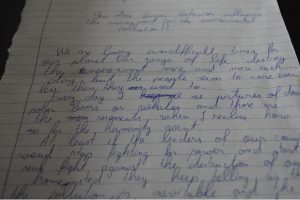
The idea was to organize a competition based on creative writing in the 12th grade. Of course thematically appropriate. So I thought about which topic could be interesting for the target group and how I could implement it. The topic was “How does human behavior influences the environment ( or the environmental pollution) ?”
I decided to leave it up to the students to choose which text form to use, so it could be an essay, a poem, a song or something like that. The idea was to give the students the plan so that each student could write something. One week after the writing I should go back to the same class to “award” the best text and go deeper in the topic.
So I went to school with this plan. I presented my idea to the students in the presence of the teacher and focused on the free choice of text. I think this was something new for the students. The focus, as mentioned above, is on non-formal education. I wanted the students to know that they could express themselves the way they wanted.
But (unfortunately) it went a bit different. While I was still explaining my plan, I was interrupted by the teacher who reminded the students how to structure an essay and remind them of the corresponding school lessons. She also told the students that they should substantiate their texts with many facts. I explained again that each student can express him- or herself as (s)he wishes. And that it will not evaluate with marks. So the students started writing and every student wrote something on his or her paper. I took the texts with me to read them. Contrary to my expectations, many students disregarded the teacher’s instructions and wrote very personal and poetic (regardless of a perfect structure) texts. Much to my delight.
The next week I went back to class to talk to the students about their texts. Unfortunately there was no real discussion and I decided to change the content of the lesson. I also decided not to award the best text.
Two things I learned during this activity or were a gain in knowledge for me:
1. I was very surprised by the content of the students’ texts. Most of the students drew a gloomy picture of the future in relation to the environment and seemed more or less helpless and powerless in their responsibility.
2. I and we propagate again and again a knowledge transfer based on non-formal education. Not only since our project, but for many years. I have found (and not only in this activity) that it is still new territory for teachers and that they find it difficult to implement or accept this form of education.
It’s no big surprise that some teachers have a hard time with these aspects. I think that the school system (not only in Romania!) is largely based on a clearly formal curriculum and this determines the everyday life and thinking of the teachers. So they are certainly very well educated in their field and know how to transport this knowledge in the way mentioned above.
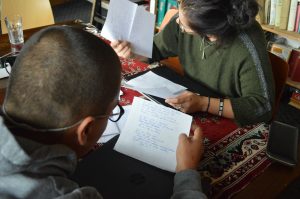
Nevertheless, I and we try to implement other aspects of education, not only the mediation, but also the contents into the everyday school life.
Fortunately, we have cooperations with the schools in the area and can slowly but surely introduce a different kind of mediation. Not to replace the teachers, but to supplement them!
Schimb de Tineri în Sicilia / testimoniale participanților
 În prima săptămână a lunii septembrie, o echipă formată din 5 tineri din Curba de Cultura s-a alăturat unui schimb de tineret Erasmus + la Polizzi Generosa, în inima Siciliei. HeritAge, un schimb dedicat împărtășirii de practici despre construcția naturală a fost organizat de noii noștri parteneri sicilieni, Porto di Terra. Iată cum au descris tinerii noștri această experiență specială în inima naturii:
În prima săptămână a lunii septembrie, o echipă formată din 5 tineri din Curba de Cultura s-a alăturat unui schimb de tineret Erasmus + la Polizzi Generosa, în inima Siciliei. HeritAge, un schimb dedicat împărtășirii de practici despre construcția naturală a fost organizat de noii noștri parteneri sicilieni, Porto di Terra. Iată cum au descris tinerii noștri această experiență specială în inima naturii:
“Despre această nouă experiență pot spune că a fost unică cu noi oameni cu caractere diferite. Am trăit experiența de a construi acoperișul unei “paglaio” folosind doar materiale naturale “cannedda” și “tisa”, și de a consolida pereții unei alte “paiaio” folosind din nou doar materiale naturale, lut nisip apă fan pământ galben”. Pentru mulți dintre noi a fost o experiență nouă în care am interacționat direct cu locul cu materialele absolut cu toată natură, iar cu siguranță pentru mine a fost prima dată când am interacționat direct doar cu materiale naturale chiar dacă știam de existența și folosirea lor. Am experimentat un nou stil de viață în care am dormit toată perioada proiectului în cort, am experimentat mâncărurile tradiționale dar într-o varianta vegetariană descoperind posibilitatea de a adopta un nou stil de alimentație. După o drumeție de aproape 5 ore în munții sicilieni am rămas cu imaginea unei familii de căprioare care conviețuiau împreună cu o familie de porci mistreți și bineînțeles cu imagini ale peisajului de neuitat. După vizita celui mai apropiat orășel de camping-ul nostru am rămas cu detalii despre istoria orășelului cum a fost construit, cum majoritatea persoanelor tinere l-au părăsit treptat, cum majoritatea bisericilor au fost transformate în case. În ultima seară a proiectului ne-am luat rămas bun de la loc de la toți noii noștri prieteni făcuți pe parcursul schimbului, pe ritmuri de muzică tradițională cântate de invitații noștri locali pentru a celebra noul acoperiș și noua imagine a pereților din casele naturale.” – Alex
 “Unul dintre cele mai importante aspecte ale acestui schimb de tineri a implicat bucuria și vibe-ul pozitiv pe care îl pot produce lucrurile simple. Într-o societate care pune accent pe ideea de a aprecia cât mai mult partea materială, am întâlnit aici, la Porto di Terra comuniunea perfectă între om și natură. O adevărată atmosfera relaxată și relaxantă, oameni mereu zâmbitori și înțelegători. Împreună cu tinerii din Spania, Italia, Portugalia, Slovacia și Grecia am adunat și pregătit materialele necesare, am reconstruit două dintre casele tradiționale, denumite Pagliaio și am explorat frumusețile parcului național Maddona printr-o vizită în orașul Polizzi Generossa și în special printr-o drumeție pe munte. Schimbul de tineri s-a încheiat cu dans, muzică live tradițională și multă bucurie pe fețele tuturor.” – Simina
“Unul dintre cele mai importante aspecte ale acestui schimb de tineri a implicat bucuria și vibe-ul pozitiv pe care îl pot produce lucrurile simple. Într-o societate care pune accent pe ideea de a aprecia cât mai mult partea materială, am întâlnit aici, la Porto di Terra comuniunea perfectă între om și natură. O adevărată atmosfera relaxată și relaxantă, oameni mereu zâmbitori și înțelegători. Împreună cu tinerii din Spania, Italia, Portugalia, Slovacia și Grecia am adunat și pregătit materialele necesare, am reconstruit două dintre casele tradiționale, denumite Pagliaio și am explorat frumusețile parcului național Maddona printr-o vizită în orașul Polizzi Generossa și în special printr-o drumeție pe munte. Schimbul de tineri s-a încheiat cu dans, muzică live tradițională și multă bucurie pe fețele tuturor.” – Simina
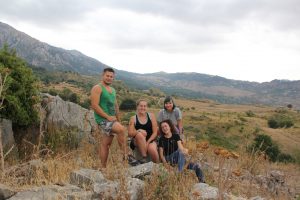 “Heritage”…un Youth Exchange într-o altă lume,un schimb care m-a rupt de realitate și care mi-a dat o bună lecție de viață. Subiectul acestui schimb a fost despre construcțiile din materiale naturale. Campingul a fost într-o pădurice, mâncarea a fost vegetariană,din produse naturale crescute în grădina organizatorilor. Am învățat să construim pagliaio, o căsuța pe care foarte puțini oameni mai știu să o facă. Acoperișul constă din mănunchiuri de disa și cannedda, iar pereții dintr-un amestec făcut din paie,pământ galben și nisip cu calcar. Într-una din zile am vizitat satul Polizzi Generosa căruia i-am descoperit istoria și un atelier de lucru în lut unde am fost lăsăți să experimentăm tainele lutului. O altă zi a fost dedicată urcatului pe munte. Până în vârf am întâlnit căprioare și porci mistreți. În ultima zi am celebrat terminarea construirii casei “pagliao”. Subiectul schimbului și-a atins scopul foarte bine și pe lângă acesta ne-am distrat în timp ce munceam, am învățat să lucrăm în echipa și am învățat să apreciem natura,să ii vedem frumusețea în toată splendoarea ei. Mi-am înfrânt multe temeri peste care nu mă așteptăm sa trec. Din acel stil natural de viață am primit niște lecții care mă vor ajută în viață de zi cu zi.” – Andreea
“Heritage”…un Youth Exchange într-o altă lume,un schimb care m-a rupt de realitate și care mi-a dat o bună lecție de viață. Subiectul acestui schimb a fost despre construcțiile din materiale naturale. Campingul a fost într-o pădurice, mâncarea a fost vegetariană,din produse naturale crescute în grădina organizatorilor. Am învățat să construim pagliaio, o căsuța pe care foarte puțini oameni mai știu să o facă. Acoperișul constă din mănunchiuri de disa și cannedda, iar pereții dintr-un amestec făcut din paie,pământ galben și nisip cu calcar. Într-una din zile am vizitat satul Polizzi Generosa căruia i-am descoperit istoria și un atelier de lucru în lut unde am fost lăsăți să experimentăm tainele lutului. O altă zi a fost dedicată urcatului pe munte. Până în vârf am întâlnit căprioare și porci mistreți. În ultima zi am celebrat terminarea construirii casei “pagliao”. Subiectul schimbului și-a atins scopul foarte bine și pe lângă acesta ne-am distrat în timp ce munceam, am învățat să lucrăm în echipa și am învățat să apreciem natura,să ii vedem frumusețea în toată splendoarea ei. Mi-am înfrânt multe temeri peste care nu mă așteptăm sa trec. Din acel stil natural de viață am primit niște lecții care mă vor ajută în viață de zi cu zi.” – Andreea
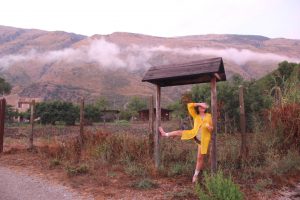 “Probabil primul Schimb de Tineri din experiența mea când am făcut cu adevărat un schimb. Am învățat mult prin lucrări practice, luând informații și povești și, de asemenea, de la modelele pe care le-am găsit între oamenii cu care am petrecut săptămâna aceasta. Am lăsat acolo mica mea contribuție la pagliaio (casele tradiționale siciliene) și am primit atât de multe: cunoștințe despre natură și puterea ei, noi prietenii, „cea mai bună mâncare pe care o vei mânca vreodată” și prima mea reprezentație live, am cântat singura jumătate dintr-un cântec pe care îl pot cânta la chitară și a însemnat foarte mult pentru mine. Sunt recunoscătoare pentru această săptămână diferită din viața mea și pentru toate ființele uimitoare pe care le-am cunoscut, inclusiv câinii și țânțarii. ”(Citiți în timp ce ascultați https://youtu.be/Op0dN_U4L5s) – Laura
“Probabil primul Schimb de Tineri din experiența mea când am făcut cu adevărat un schimb. Am învățat mult prin lucrări practice, luând informații și povești și, de asemenea, de la modelele pe care le-am găsit între oamenii cu care am petrecut săptămâna aceasta. Am lăsat acolo mica mea contribuție la pagliaio (casele tradiționale siciliene) și am primit atât de multe: cunoștințe despre natură și puterea ei, noi prietenii, „cea mai bună mâncare pe care o vei mânca vreodată” și prima mea reprezentație live, am cântat singura jumătate dintr-un cântec pe care îl pot cânta la chitară și a însemnat foarte mult pentru mine. Sunt recunoscătoare pentru această săptămână diferită din viața mea și pentru toate ființele uimitoare pe care le-am cunoscut, inclusiv câinii și țânțarii. ”(Citiți în timp ce ascultați https://youtu.be/Op0dN_U4L5s) – Laura